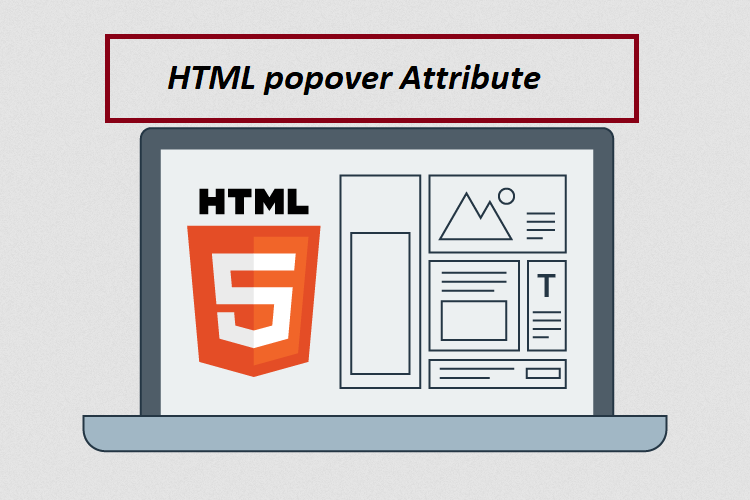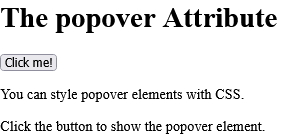
|
Definition and UsageThe A popover element will be invisible until it is invoked by another element. The other element must have a The popover element will be placed on top of all other content, and by clicking the popovertarget element, the popover element will toggle between showing and hiding: The popover element can be a single HTML element, or an entire section of HTML elements. See examples below. Applies toThe
Browser Support
|
How to Add a <h1> element with a popover attribute, and a button to show/hide it - HTML popover Attribute
Click the button and it will toggle between showing and hiding the popover element.
index.html
Example:
HTML
<!DOCTYPE html>
<html>
<body>
<h1>The popover Attribute</h1>
<h1 popover id="myheader">Hello</h1>
<button popovertarget="myheader">Click me!</button>
<p>Click the button and it will toggle between showing and hiding the popover element.</p>
</body>
</html>
Output should be:

How to Use a DIV element as a popover element - HTML popover Attribute
You can style popover elements with CSS. Click the button to show the popover element.
index.html
Example:
HTML
<!DOCTYPE html>
<html>
<body>
<style>
#mydiv {
text-align:center;
padding:40px;
background-color:lightblue;
font-family:"Segoe UI", Tahoma, Geneva, Verdana, sans-serif;
}
</style>
<h1>The popover Attribute</h1>
<div popover id="mydiv">
<h2>Popover</h2>
<hr>
<p>A popover is an element that is placed on top of everything else.</p>
<p>It can be used when you want to tell something important.</p>
<button popovertarget="mydiv" popovertargetaction="hide">Close</button>
</div>
<button popovertarget="mydiv">Click me!</button>
<p>You can style popover elements with CSS.</p>
<p>Click the button to show the popover element.</p>
</body>
</html>
Output should be:

| html popover attribute |
| How to Add a <h1> element with a popover attribute, and a button to show/hide it - HTML popover Attribute | HTML Attribute |
| How to Use a DIV element as a popover element - HTML popover Attribute | HTML Attribute |
Read Full: | HTML Attribute |
Type: | Develop |
Category: | Web Tutorial |
Sub Category: | HTML Attribute |
Uploaded by: | Admin |
Views: | 100 |
Reffered: https://www.w3schools.com/tags/att_popover.asp
